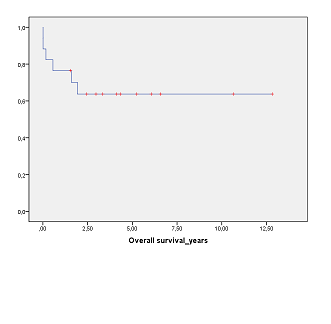
Contributions
Abstract: PB1423
Type: Publication Only
Session title: Acute myeloid leukemia - Clinical
Background
Acute promyelocytic leukemia (APL) is a rare subtype of AML which represents < or = 10% of childhood acute myelogenous leukemia.
Aims
We conducted a retrospective analysic diagnosed between January 2008 to December 2016 and actively followed. The hematologic complete remission (CR) rate and overall survival (OS) rate were evaluated. Prognostic factors and complications were investigated
Methods
We studied the outcomes of children, up to 18 years of age, with APL treated by acute promyelocytic leukemia (APL) 2005 protocol, in Hematology Departement of Aziza Othmana Hospital.
We conducted a retrospective analysic diagnosed between January 2008 to December 2016 and actively followed. The hematologic complete remission (CR) rate and overall survival (OS) rate were evaluated. Prognostic factors and complications were investigated
Results
A total of 13 patients with a median age of 9 years (range, 2-18 years) were included. We had 9 boys vs 8 girls, sex ratio 1.1.
76.5 % patients had hemorrhagic findings at admission. Severe bleeding manifested as intracranial haemorrhage was present in one patient. Disseminated intravascular coagulation (DIC) was diagnosted in 11 patients (65%). We stratified APL patients into three risk subgroups using Sanz score: low risk (1 patient), intermediate risk (6 patients) and high risk (10 patients).
All patients were treated with AIDA 2005 protocol. Induction death rate was 6%. Nine patients showed side effects of ATRA such as differentiation syndrome (7 patients), pseudotumor cerebri (one patient) and Sweet syndrome (one patient).
The median overall survival of the live patients was 8.4 years. The 5-year overall survival was estimated at 64%. On univariate analysis of overall survival, age, number of leukocytes, Prothrombin Time, risk classification and blast marrow infiltration were associated with overall survival. Sex, and DIC were not significant predictors of overall survival.

Conclusion
Life-threatening bleeding was the primary problem in APL. Urgent treatment with ATRA is a critical factor to reduce early losses.
Keyword(s):
Abstract: PB1423
Type: Publication Only
Session title: Acute myeloid leukemia - Clinical
Background
Acute promyelocytic leukemia (APL) is a rare subtype of AML which represents < or = 10% of childhood acute myelogenous leukemia.
Aims
We conducted a retrospective analysic diagnosed between January 2008 to December 2016 and actively followed. The hematologic complete remission (CR) rate and overall survival (OS) rate were evaluated. Prognostic factors and complications were investigated
Methods
We studied the outcomes of children, up to 18 years of age, with APL treated by acute promyelocytic leukemia (APL) 2005 protocol, in Hematology Departement of Aziza Othmana Hospital.
We conducted a retrospective analysic diagnosed between January 2008 to December 2016 and actively followed. The hematologic complete remission (CR) rate and overall survival (OS) rate were evaluated. Prognostic factors and complications were investigated
Results
A total of 13 patients with a median age of 9 years (range, 2-18 years) were included. We had 9 boys vs 8 girls, sex ratio 1.1.
76.5 % patients had hemorrhagic findings at admission. Severe bleeding manifested as intracranial haemorrhage was present in one patient. Disseminated intravascular coagulation (DIC) was diagnosted in 11 patients (65%). We stratified APL patients into three risk subgroups using Sanz score: low risk (1 patient), intermediate risk (6 patients) and high risk (10 patients).
All patients were treated with AIDA 2005 protocol. Induction death rate was 6%. Nine patients showed side effects of ATRA such as differentiation syndrome (7 patients), pseudotumor cerebri (one patient) and Sweet syndrome (one patient).
The median overall survival of the live patients was 8.4 years. The 5-year overall survival was estimated at 64%. On univariate analysis of overall survival, age, number of leukocytes, Prothrombin Time, risk classification and blast marrow infiltration were associated with overall survival. Sex, and DIC were not significant predictors of overall survival.

Conclusion
Life-threatening bleeding was the primary problem in APL. Urgent treatment with ATRA is a critical factor to reduce early losses.
Keyword(s):


